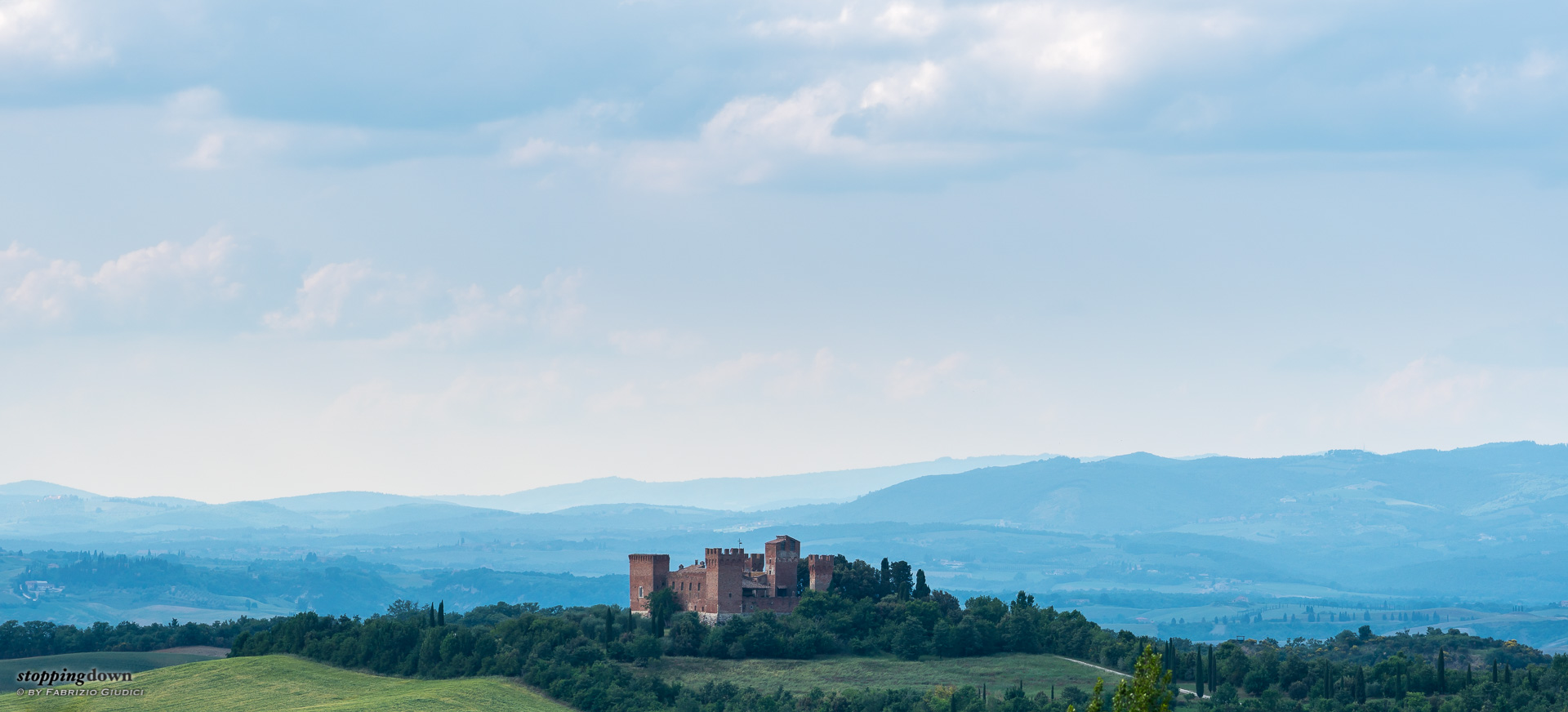After months focused almost exclusively on flowers (both for necessity and for improving my technique) I'm back from four days in southern Tuscany, entirely devoted to landscape. After some failed attempts in the past years — due to various reasons — I was able to explore a wonderful but less known area at the very south of the province of Siena.
But I'll write about that in a later post. Now I'd like to write some impressions about the Sony α6300, the latest entry in my bag, since I extensively used it on the field.
Sony α6300 + Sony FE 70-200mm F4 G OSS @ 200 mm, 1/250 sec @ ƒ/8, -0.30 EV, ISO 100, panorama of two shots
Il castello di Gallico.
For the first time I in my life I went out with a three-camera-bodies approach. Basically I bought the third camera body for this main reason: to minimise the lens changes on the field. I admit this is partly due to my laziness, but there is also an objective reason: in Tuscany I drive for hundreds of kilometres through white roads. My car gets so filled with dust than it usually takes weeks to completely remove it from the inner parts, and thus there are higher ratios than usual to have dirt on the sensor.
Sony α6300 + Sony FE 70-200mm F4 G OSS @ 113 mm, 1/160 sec @ ƒ/8, +0.30 EV, ISO 320
Radicofani, ginestre e trifoglio fiorito.
The typical setup I used was to have the 16-70 mm, the 70-200 mm and the 150-600 mm always mounted and ready. In some cases, the 150-600 mm was removed in favour of the 10-18mm. In this season the countryside is also filled with flowers, and an alternative take could have been to have the 150-600 mm replaced by a macro lens.
Sony α6300 + Sony FE 70-200mm F4 G OSS @ 93 mm, 1/250 sec @ ƒ/8, +0.30 EV, ISO 320
Paesaggio con il Monte Cetona.
Some of the really welcome new features of the camera are the better resolution in the EVF (back as the one in the NEX-6) and a very high quality 4K movie recording (up to 100 mbps). While taking confidence with the new camera (ergonomics are very similar to the α6000, with some differences) I discovered an apparently minor feature of the α6300 that I wasn't even aware of, but that could possibly be one of the greatest ones: the capability of auto-focusing while in focus magnifier mode.
Up to the α6000, pressing the shutter button cancels the focus magnifier mode. With an option of the α6300, you can stay in that mode, and auto-focusing still works (there's a cross shaped marker which indicates where focusing is performed).
Sony α6300 + Sony FE 70-200mm F4 G OSS @ 200 mm, 1/125 sec @ ƒ/8, ISO 200
Paesaggio con casale abbandonato.
My experience with the NEX-6 and the α6000 is that contrast-based focusing is overall more precise than the phase-based focusing I was using all the time with my Nikon DSLRs; more precise means that most of the times the camera uses the lens at its best (and it doesn't require micro-adjustments for each lens). But a minor fraction of shots get focusing completely wrong (even though the camera confirms the lock).
Sony α6300 + Sony FE 70-200mm F4 G OSS @ 200 mm, 1/125 sec @ ƒ/8, +0.70 EV, ISO 100
Paesaggio con Castiglione d'Orcia.
Usually I notice the problem in the EVF (less easily on the α6000 because of the lower resolution) and I repeat focusing and shooting a few times: in most cases at least one attempt is fine. But a subset of this fraction still fails. It's a very low percentage: a rough estimate is that I'm probably losing a keeper out of one hundred, so nothing really important.
Sony α6300 + Sigma 150-600mm ƒ/5-6.3 DG OS HSM C @ 388 mm, 1/100 sec @ ƒ/8, +0.30 EV, ISO 200, beanbag.
Controluce serale.
Should I run into a possibly remarkable photo, I'd stop and double-check the sharpness of the shot before moving on; eventually I'd shot again in manual focusing mode. Unfortunately it's not always easy while hand-holding: with longer focals the image in the EVF is not stable enough to manual focus while in magnifier mode. So, these cases, while really rare, are a significant annoyance that requires setting up the tripod, or using a beanbag.
Sony α6300 + Sony FE 70-200mm F4 G OSS @ 70 mm, 1/320 sec @ ƒ/8, -0.30 EV, ISO 100, panorama of two shots
Paesaggio dell'alta Val d'Orcia con filare di cipressi.
Sony α6300 + Sony FE 70-200mm F4 G OSS @ 72 mm, 1/160 sec @ ƒ/8, +0.70 EV, ISO 100
Laghetto artificiale nei pressi di Mucigliani.
The problem with focusing happened in some circumstances with the α6300; but in all cases in which I activated the focus magnifier and refocused while in that mode with a lock confirmation I achieved a sharp result. In the rare cases in which auto-focusing failed even in magnifier mode (just three times in four days) I was immediately visually aware of the problem, so I suppose I'll never risk again that the thing goes undetected.



















